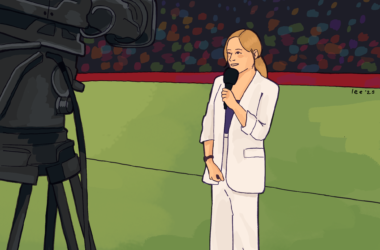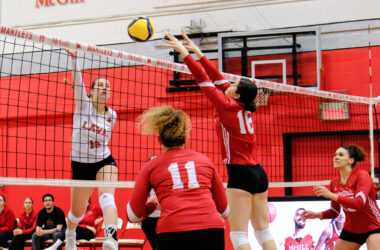With March Madness upon us, spectators sometimes forget that there will actually be two sports on display throughout the competition: basketball and cheerleading. NCAA cheerleaders, unlike their compatriots in the NFL and the NBA, deserve that name. Professional sports “cheerleading” would in reality be more properly referred to as dancing, since these teams’ performances are more akin to what you might see on a Saturday night at a gentleman’s club than what goes on at cheerleading national championships.
NFL and NBA cheerleading is to the sport of cheerleading what powderpuff football is to the Superbowl: an oversexed, stereotypically feminine voyeuristic spectacle that completely denigrates a legitimate sport. It is impossible for anyone familiar with competitive cheerleading to deny its classification as a sport. It combines gymnastics, dance, endurance, performance, and pure athleticism. It’s as physically and emotionally demanding as other competitive sports. It’s the activity that sends the highest number of high school and college athletes to the hospital every year.
However, for as long as professional sports cheerleaders continue to be known by that moniker, real cheerleading will never reach its full potential. Although the latter’s popularity has exploded, professional sport cheerleaders remain the most visible “cheerleaders” on the continent, and thus inform the majority of society’s perception of what it is that cheerleaders do. If the extent of your cheerleading knowledge is limited to flashes of half-naked women jumping up and down on the sidelines, it’s understandable to be sceptical of its classification as a sport. However, most of these women would not last five minutes at a competitive cheerleading team’s practice, let alone make the team.
That raises another issue. Many of the best cheerleaders, especially at the university and college levels, are male. Professional sport cheerleading teams, however, are composed entirely of women. This further stigmatizes society’s conception of the sport as well as the male athletes who have devoted their lives to it. These men work as hard as the football and basketball players they are there to support, and are in fact often much stronger and more physically fit.
Admittedly, both types of cheerleading share similarities in terms of physical appearance. However, unlike professional sports cheerleading, competitive cheerleading makeup and outfits are not about sex. They’re about visibility and functionality. Just like gymnastics and figure skating, heavy makeup is necessary in order to be seen by judges and large crowds that are often located far from the athletes. In addition, cheerleading is a sport in which flexibility is paramount; any outfit that constricts the athletes’ movement would make feats such as a back handspring full twist or a front tuck basket toss impossible to execute correctly.
With an unprecedented surge in popularity, the codification and standardization of its rules and regulations, and the entrenchment of an entire subculture, competitive cheerleading has come a long way in the past twenty years. But there’s one thing that’s holding it back from being on par with football, basketball, soccer and hockey. It’s time to stop calling the mockery that de-legitimizes both the sport and its athletes what it is not – cheerleading.








